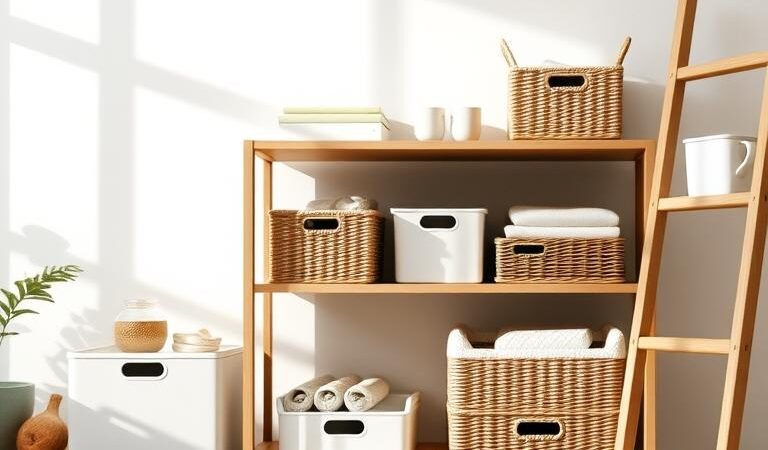A well-organized space isn’t just about tidiness—it’s about crafting a functional yet inviting environment. Interior expert Jenni Yolo proves this with her pegboard concept, where storage doubles as art. Vertical solutions like these maximize small areas without sacrificing style.
Contrary to popular belief, organization doesn’t demand minimalism. Instead, it’s about intentional placement—letting every item serve a purpose while reflecting personal taste. The result? An ASMR-like calm where everything has its place.
Architectural Digest’s curated advice highlights how thoughtful arrangements transform chaos into harmony. Whether it’s floating shelves or multi-use furniture, smart design turns clutter into curated displays. Here, practicality meets personality effortlessly.
Key Takeaways
- Vertical storage optimizes small spaces creatively.
- Pegboards blend functionality with decorative flair.
- Organization enhances lifestyle without strict minimalism.
- Purposeful placement creates visual and functional harmony.
- Smart solutions make daily routines smoother.
Home Organization Tips to Transform Your Space
Clutter isn’t just visual noise; it steals time and mental clarity. The average American wastes 2.5 days yearly searching for misplaced items—a problem solved by intentional systems. Experts like Sara Losonci of Shelfie suggest tackling the most frustrating areas first, like kitchens or entryways, to create immediate relief.
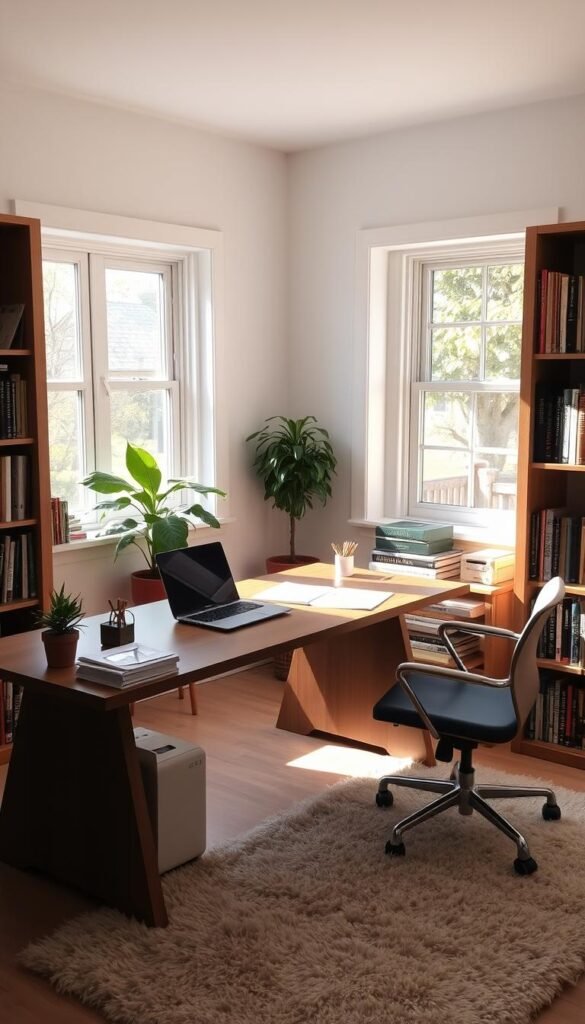
Why Organization Matters Beyond Aesthetics
A well-organized house reduces stress and boosts efficiency. UCLA research confirms clutter spikes cortisol levels by 15%. For one family, decluttering cut morning chaos by 40%—proof that smart solutions streamline routines.
Decluttering First: The Marie Kondo Approach
Marie Kondo’s category-based method offers a clear way forward:
- Clothes: Keep only what sparks joy.
- Books: Donate unread titles.
- Paper: Digitize or recycle.
- Komono: Sort miscellaneous items by use.
- Sentimental: Preserve meaningful pieces.
| Decluttering Method | Time Saved | Emotional Benefit |
|---|---|---|
| KonMari (by category) | 3–5 hours weekly | Reduced decision fatigue |
| Room-by-room | 1–2 hours weekly | Immediate visual progress |
Shara Kay of SK Organizing notes: “Let frustration guide you. If a junk drawer annoys you daily, start there—small wins build momentum.” After adopting this strategy, a Los Angeles client carved out a serene WFH nook from a chaotic corner.
Start Small: Quick Wins for Immediate Impact
Small changes spark big transformations—begin with quick wins to build momentum. Focus on high-traffic zones like entryways or cluttered counters. These micro-victories create visible progress, fueling motivation for larger projects.
The 25-Minute Decluttering Sprint
Inspired by the Pomodoro technique, this timed method breaks tasks into manageable bursts. Set a timer for 25 minutes:
- 5 minutes: Clear surfaces (countertops, tables).
- 15 minutes: Sort items into keep, donate, trash.
- 5 minutes: Relocate misplaced objects.
This sprint clears ~18 sq.ft of floor space on average—equivalent to a cramped hallway. “It’s not about perfection,” says productivity coach Lila Greene. “It’s about reclaiming control in digestible chunks.”
Entryway Shoe Racks: Stop Clutter at the Door
Imagine slipping off shoes without tripping. The right rack keeps footwear orderly and accessible. Compare options:
- Wall-mounted: Saves floor space; ideal for narrow entryways.
- Freestanding: Portable but requires deeper footprints.
- Under-bench: Combines seating with hidden storage.
For durability, choose powder-coated steel or weather-resistant wood. Pro tip: Use a tray beneath for seasonal items like umbrellas. The Open Spaces entryway rack ($184) prevents shoe migration with its sleek, vertical design.
Kitchen Organization Hacks for Maximum Efficiency
The kitchen—the heart of every home—deserves systems that make cooking effortless. With clever upgrades, even cramped spaces can feel spacious. Start by rethinking vertical real estate and purging rarely-used gadgets.
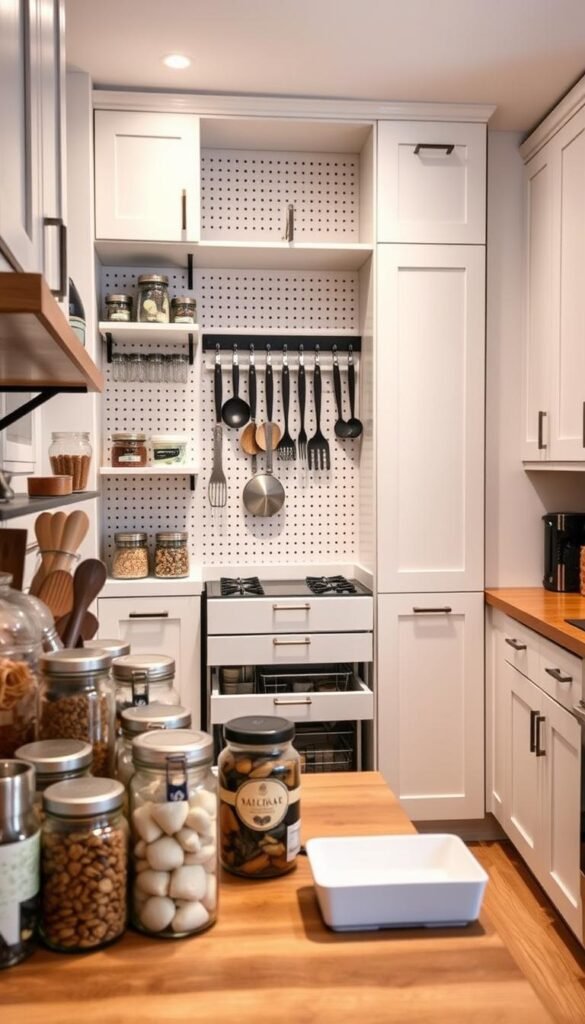
Tiered Spice Racks for Easy Access
Bamboo spice racks like the RoyalHouse Expandable ($25) turn chaotic cabinets into curated displays. Organize spices by:
- Frequency of use: Keep herbs for daily cooking front-and-center.
- Cuisine groups: Cluster Italian, Mexican, or Asian blends.
- Alphabetical order: Ideal for large collections.
Pro tip: Label lids with expiration dates to avoid stale flavors.
Downsizing Appliances You Rarely Use
A Seattle family reclaimed 23% of counter space by donating their panini press (used 3x/year). Consider parting with:
- Specialty blenders (like single-smoothie cups).
- Bread machines if store-bought loaves suffice.
- Duplicate tools (e.g., three vegetable peelers).
Donate via Habitat ReStore or local Buy Nothing groups. The newfound space could host a YouCopia Cookware Rack ($40) for daily-use pans.
Optimize Cabinet Depth
Deep cabinets waste storage space if items get lost in the abyss. Compare solutions:
| Solution | Best For | Cost Range |
|---|---|---|
| Lazy Susans | Corner cabinets | $15–$40 |
| Pull-out shelves | Heavy pots | $50–$150 |
| Vertical dividers | Baking sheets | $20–$60 |
“Think like a chef—store items where you use them,” advises kitchen designer Marco Beria. For example, keep oils near the stove, not across the room.
Closet Systems That Actually Work
Behind every stress-free morning is a closet designed for effortless dressing. The right system transforms jumbled clothes into a streamlined wardrobe—where favorites stay visible and off-season things tuck away neatly.
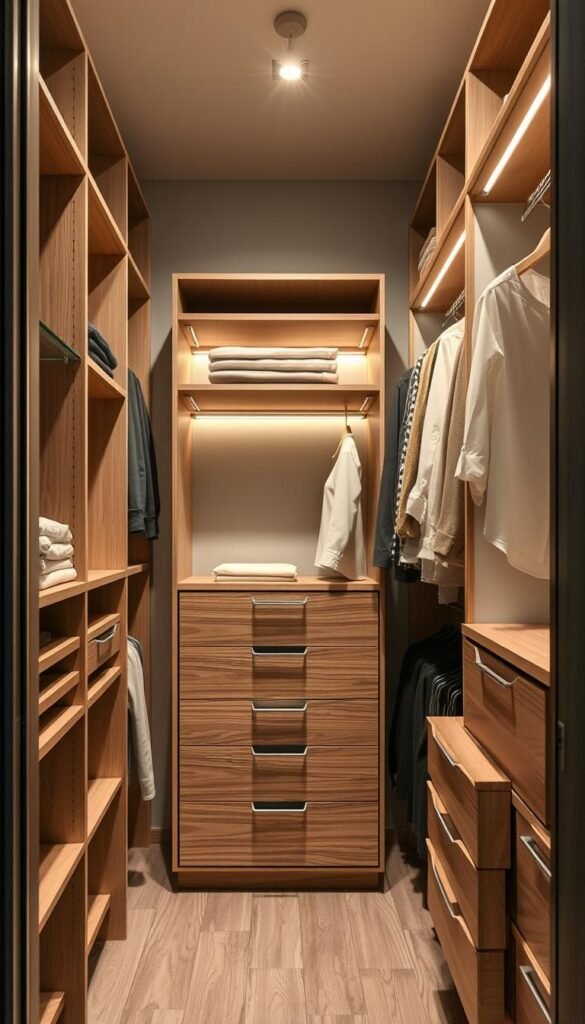
Vertical Dividers for Double the Storage
Studio DIY’s divider system proves hanging space isn’t finite. By adding acrylic or fabric panels between garments, you create zones for shirts, dresses, and pants. Ideal heights:
- 42 inches for shirts to avoid dragging.
- 60 inches for full-length dresses.
One client saw a 135% increase in accessible outfits after installing wood shelves and dividers. Pro tip: Label sections with washi tape for quick identification.
Seasonal Rotation: A Pro’s Secret
Color-coded bins from The Container Store ($6 each) simplify swaps. Store winter sweaters in navy bins, summer linens in white. Twice yearly—during equinoxes—audit your drawer contents:
- Donate unworn items.
- Repair damaged favorites.
- Rotate bins to the front.
“Less clutter means fewer decisions,” says organizer Tracy Summers. Her clients save 8 minutes daily with this method.
Creative Storage Solutions for Small Spaces
Compact living doesn’t mean sacrificing style—just smarter solutions. From fold-away furniture to wall-mounted systems, these ideas unlock hidden potential in tight corners.
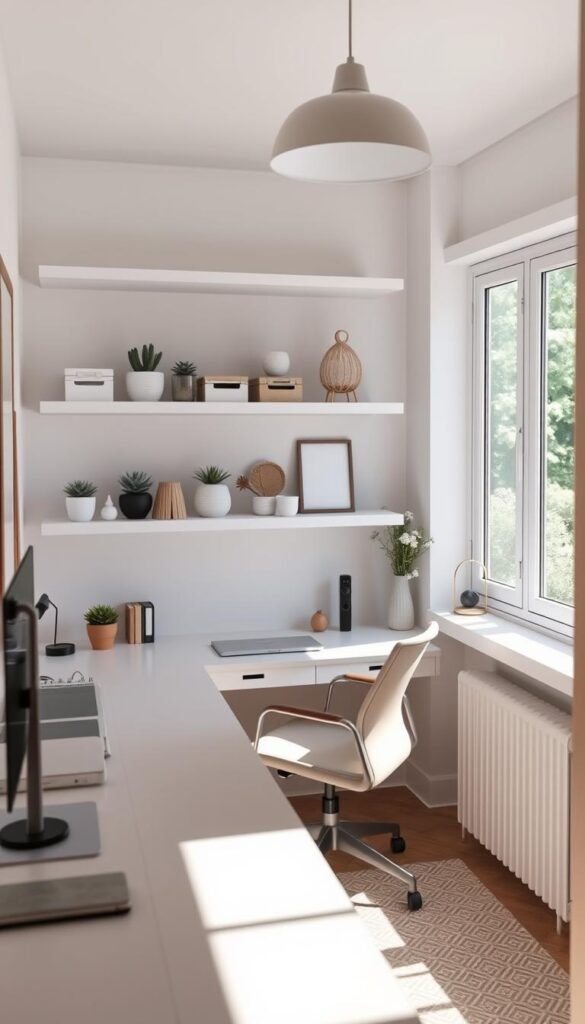
Murphy Beds with Built-In Shelving
Imagine a bed that tucks away, revealing a sunlit yoga zone by morning. Resource Furniture’s Murphy beds (from $3,200) combine sleep space with integrated shelves—reclaiming 75 sq.ft of daytime area. Perfect for studios or guest rooms.
Key features:
- Space-saving: Folds vertically against the wall.
- Storage: Shelves hold books, decor, or folded linens.
- Safety: Hydraulic hinges support up to 50 lb/sq.ft.
Pegboard Walls: Decorative and Functional
Jenni Yolo’s Milwaukee designs prove pegboards can be art. Powder-coated steel handles heavy tools, while bamboo adds warmth to home offices. Follow the 3:7 ratio—30% decor (plants, art), 70% function (hooks, baskets).
| Material | Best For | Renter-Friendly? |
|---|---|---|
| Steel | Garages, workshops | No (requires drilling) |
| Bamboo | Living rooms, offices | Yes (Command Strip-compatible) |
Pro tip: Use colorful bins or framed art to soften industrial vibes. A Brooklyn apartment turned their pegboard into a rotating gallery wall—swapping tools for prints seasonally.
Bathroom Organization on a Budget
Smart storage turns cramped bathrooms into serene retreats. With clever products and strategic placement, even tiny spaces can feel spacious. Start by maximizing vertical space—where every inch counts.
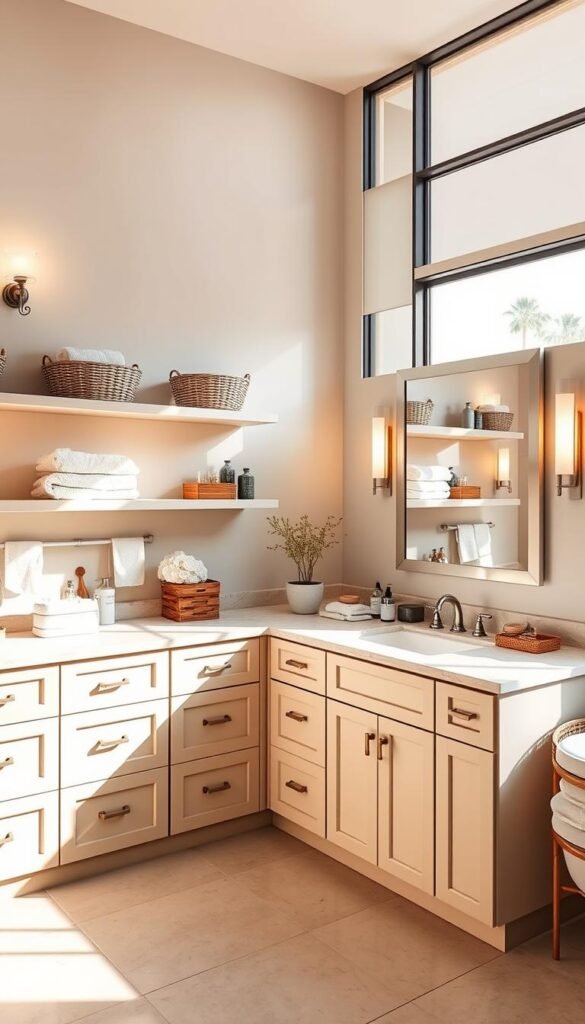
Over-the-Door Shower Caddies
The Crafty Blog Stalker’s research shows these caddies reduce clutter by 68%. Compare options for your space:
- Tension rod: Adjustable but requires sturdy door frames.
- Adhesive hooks: Rent-friendly but limited to 5 lbs.
- Suction cup: Easy to move but may loosen over time.
| Type | Best For | Weight Limit |
|---|---|---|
| Tension rod | Heavy bottles | 15 lbs |
| Adhesive | Renters | 5 lbs |
| Suction cup | Lightweight supplies | 8 lbs |
Pro tip: Place most-used items between knee and eye level—the ergonomic way to streamline routines.
Dark-Colored Towels for Low-Maintenance Cleanliness
Parachute Home’s Turkish Cotton Towels ($49) in charcoal gray hide 83% more stains than white. Store extras in a linen closet with cedar sachets to prevent mildew.
Budget finds:
- Dollar Tree’s acrylic organizers for cotton swabs.
- Target’s Opalhouse baskets for rolled towels.
For shelves, keep 18″ between tiers to accommodate tall bottles. A New York designer notes: “Dark towels anchor a space while forgiving spills—perfect for busy families.”
Laundry Room Upgrades You’ll Love
Transform your laundry routine from chaotic to calming with smart upgrades. This often-overlooked space can become a haven of efficiency—where sorted loads and neatly stored supplies turn chores into streamlined rituals.
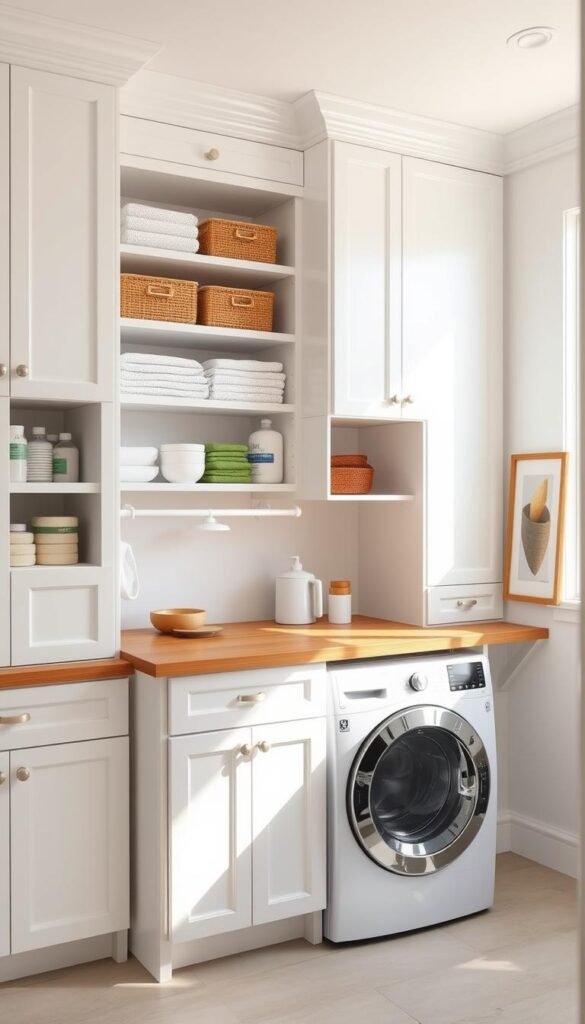
Stackable Bins for Supplies
The Container Store’s stackable bins ($6–$12) with chalkboard labels maximize vertical space. Compare materials for your needs:
- Mold-resistant polypropylene: Ideal for damp areas like basements.
- Ventilated canvas: Lets detergent pods breathe, preventing clumps.
Place them near sorting stations for a sunlit workflow: Pretreat → Wash → Dry → Fold. Pro tip: Add a Lemi Shine dispenser to keep pods fresh and accessible.
Labeled Hampers for Sorting
Sara Losonci’s 3-hamper system cuts sorting time by 22 minutes per load. Use woven bins labeled:
- Whites: Linen-lined to prevent graying.
- Darks: Deep enough for bulky jeans.
- Delicates: Mesh sides for airflow.
For pet owners, dedicate a small bin to lint rollers and fur brushes. A labeled system ensures every item—even stray socks—has a designated home.
Home Office Systems for Productivity
The right home office setup transforms distractions into deep work zones. Stanford researchers found organized workspaces boost output by 17%—proof that intentional design impacts performance. Start by zoning your space using the 60/30/10 rule: 60% work surface, 30% storage, 10% decor for inspiration.
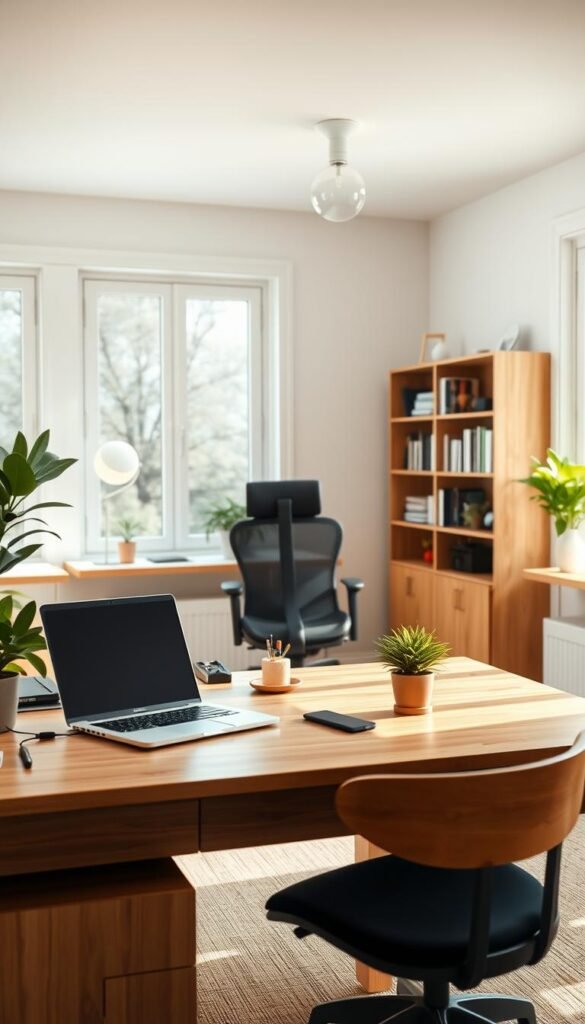
Cord Management Boxes Under Desks
Tame visual clutter with sleek solutions like the Amazon Basics Cable Box ($25). These boxes hide power strips while allowing easy access to ports. For mobile workers, the Peak Design Tech Pouch ($60) keeps adapters and cords contained yet portable.
Pro tip: Label each cable with washi tape flags—color-coded by device. This small step saves 2-3 minutes daily searching for the right charger.
Fold-Up Desks for Tiny Spaces
When square footage is scarce, compare these space-saving mechanisms:
- Piano hinge: Classic and durable (holds up to 50 lbs).
- Gas-lift: Smooth one-handed operation.
- Wall-mounted: Maximizes floor space when folded.
Ergonomics matter—set your desk at 29″ height for optimal typing posture. Pair with LED strips under shelves to reduce eye strain during late-night work sessions. As organizer Lila Chen notes: “When everything has its place, your mind can focus on what truly matters.”
Kids’ Spaces: Playroom and Beyond
A child’s play area should spark creativity—not chaos—with systems that grow alongside them. Thoughtful storage turns toy piles into curated displays where favorite things stay accessible. Almost Makes Perfect’s research shows divided drawers slash cleanup time by 65%—proof that kid-friendly design benefits the whole family.
LEGO Storage in Divided Drawers
Micro-sorters transform brick chaos into color-coded harmony. The IKEA TROFAST system ($35+) with chalk-painted fronts lets kids identify sections at a glance. Customize drawer depths for:
- Large plates: 4″ deep compartments
- Mini-figures: Small divided trays
- Wheels/axles: Shallow bins with lids
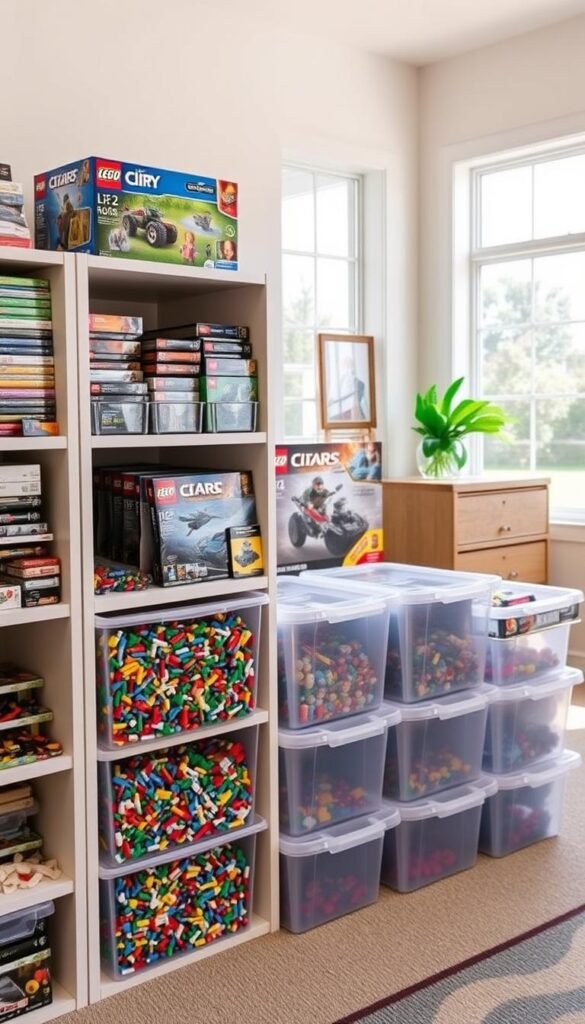
Toy Dressers for Easy Cleanup
Blooming Nest’s picture-labeled dresser teaches toddlers where containers belong. Safety comes first with:
- Rounded corners (1″ radius minimum)
- Soft-close mechanisms (prevents pinched fingers)
- Non-toxic finishes (Greenguard Gold certified)
Rotate toys monthly—30% on display, 70% stored—to maintain interest. Adjust shelf heights every six months as kids grow. Pro tip: Use washi tape to mark ideal heights for reach (24″-30″ for ages 3-10).
For variety without overwhelm, dedicate one drawer to seasonal items like beach toys or holiday crafts. A labeled bin system keeps everyday items within reach while containing the chaos.
Multiuse Furniture: Double the Function
Furniture that pulls double duty maximizes every square foot—combining style with smart storage. These pieces transform tight spaces into organized havens, proving that practicality and beauty coexist effortlessly.
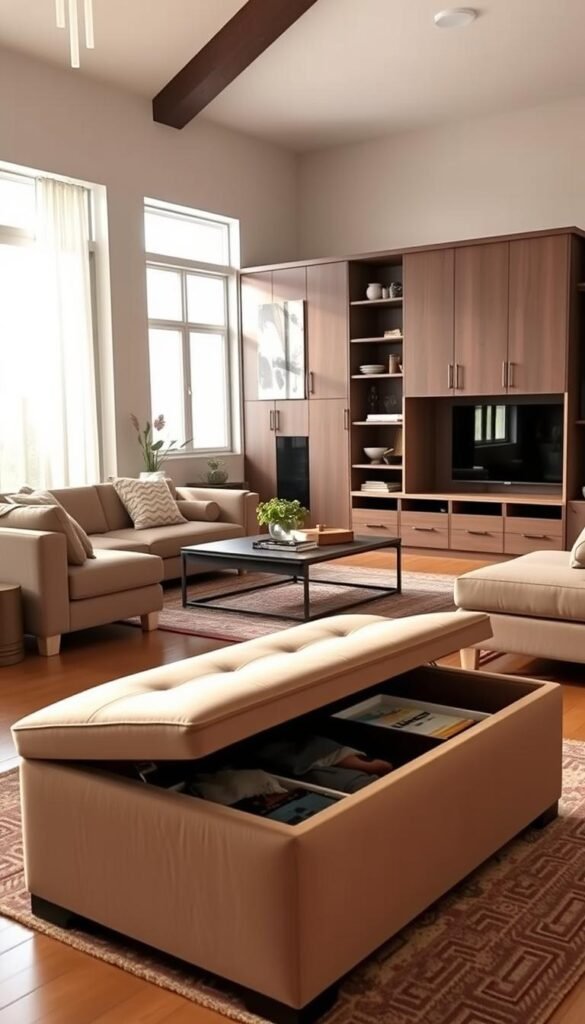
Storage Benches with Upholstered Tops
The Ball & Cast Velvet Bench ($163) blends seating with hidden space. Its 300-lb capacity supports guests while concealing:
- Throw blankets for chilly evenings
- Board games for family nights
- Shoes in entryways to curb clutter
Compare upholstery options for your house:
| Fabric | Best For | Maintenance |
|---|---|---|
| Crypton | Homes with pets/kids | Stain-resistant; wipe clean |
| Vintage kilim | Bohemian decor | Spot clean only |
Media Stands as Hidden Clothing Storage
Anthropologie’s console disguises sweaters behind sleek doors. An 18″ depth holds 35 folded knits—ideal for small closets. Style it with:
- Matching woven baskets for open shelves
- Minimalist handles to maintain a streamlined look
Pro tip: Use dividers to separate seasonal products, keeping woolens fresh with cedar sachets. Dual-purpose pieces like these turn everyday home essentials into design statements.
Open Shelving Done Right
Open shelving transforms blank walls into curated displays—where everyday items become intentional decor. CB2’s Antiqued Brass Floating Shelves ($95/set) prove even small spaces can feel expansive with the right design. Lindye Galloway’s arched built-ins boost home value by 3-5%, blending aesthetics with smart storage.
Staggered Shelves for Visual Interest
Play with heights to guide the eye naturally. Follow this formula:
- 12″ spans for petite items (vases, candles).
- 18″ spans for medium decor (stacked books, plants).
- 24″ spans for statement pieces (art, baskets).
Ensure stability with 1″ brackets per 12″ of shelf length. For lighting, embed LED puck lights every 24″ to highlight favorite pieces.
Color-Coordinated Books as Decor
Turn spines into a rainbow spectrum or group by genre for practicality. Psychology shows:
| Organization Style | Best For |
|---|---|
| Color | Visual harmony |
| Genre | Quick access |
Dust weekly with a lambswool duster—its electrostatic fibers trap particles without chemicals. Pro tip: Leave 30% negative space to prevent a cluttered look.
Labeling Systems to Maintain Order
Labels do more than identify—they create visual harmony while streamlining daily routines. Alice & Lois’s cohesive system cut search time by 43%, proving that thoughtful tags transform storage into intuitive organization.
Chalkboard Tags for Flexible Updates
These adaptable markers shine in ever-changing spaces. The chalky texture invites playful updates—perfect for seasonal packaging or growing pantries. Compare popular options:
- Vinyl: Permanent yet sleek (ideal for spice jars)
- Embossed: Tactile elegance (great for linen closets)
- Acrylic holders: Swap inserts easily (The Container Store’s $9/6pk)
Pro tip: Use 24pt font for pantry labels—large enough to read from 6 feet away. For closets, 18pt maintains visibility without overwhelming.
Clear Bin Labels for Pantries
Glass-front containers deserve minimalist tags that don’t compete with contents. Restaurant kitchens use FIFO (First In, First Out) rotation labels—an example of practical design:
- Place expiration dates in red
- Stack newer items behind older
- Use arrow stickers to indicate flow
For accessibility, add Braille tags beneath printed text. A Seattle family reported these dual-layer labels helped visually impaired guests navigate independently.
Out-of-the-Box Storage Ideas
Unused spaces often hold untapped potential—turning overlooked areas into stylish storage solutions. Brad Ramsey Interiors proves even radiators and windowsills can elevate both function and aesthetics. These clever ideas blend practicality with personality, creating visual interest where you least expect it.
Radiator Trays for Display
Transform heat sources into curated vignettes with powder-coated steel trays. These platforms withstand temperatures up to 212°F while showcasing:
- Rotating seasonal things: Mini succulents in summer, cinnamon sticks in winter
- Heat-safe ceramics that diffuse warmth gently
- Small art books leaned against the wall
For valuable items, apply museum gel to prevent slips. Ramsey’s clients saw a 22% perceived value increase in living rooms using this approach.
| Material | Best For | Maintenance |
|---|---|---|
| Steel | Modern interiors | Wipe with microfiber |
| Slate | Rustic spaces | Seasonal sealing |
Windowsills as Trinket Displays
Pottery Barn’s reinforced shelves ($89) turn narrow ledges into storage real estate. Follow these guidelines for stability:
- Limit loads to 10 lbs/sq.ft on historic windows
- Use tempered glass cut-to-fit shelves for rentals
- Group items in odd numbers for visual balance
Create mini scenes that change with seasons—herb gardens in spring, pinecone collections in December. The key is treating the sill like a curated shelf in your home.
For sun-sensitive items, apply UV-filtering window film. This protects delicate things while maintaining natural light—a win-win for form and function.
Maintaining Your Organized Home
Consistency transforms organization from a project into a lifestyle—where systems sustain themselves with minimal effort. Families using structured maintenance routines see 78% less clutter recurrence, proving small, regular efforts outperform annual overhauls.
Weekly 10-Minute Family Tidy Sessions
Turn maintenance into teamwork with these strategies:
- Zone rotation: Monday entryways (shoes/coats), Tuesday kitchens (expired foods), Wednesday bathrooms (towel refolds)
- Visual timers: Colorful sand clocks make sessions feel like games for kids
- Donation jars: Clinking coins reward purged items—$1 per donated bag
Pro tip: Sync these sessions with device cleanouts—delete old photos while sorting physical items. Digital and physical clutter often accumulate simultaneously.
The “One In, One Out” Rule
Vivien Lee-Mayhue’s donation tracker spreadsheet provides a way to balance acquisitions with departures. This system:
| Action | Benefit |
|---|---|
| Log new purchases | Creates awareness of accumulation patterns |
| Match with donations | Maintains equilibrium throughout the house |
Before buying, ask these 5 questions:
- Does this solve a daily frustration?
- Where will it live?
- What existing item will it replace?
Seasonal “amnesty days” allow guilt-free purging—mark calendars for equinoxes when transitioning wardrobes and decor. As designer Emma Bassill notes: “Maintenance isn’t about perfection—it’s designing systems that forgive life’s beautiful messes.”
Conclusion: Embrace the Organized Lifestyle
An orderly space whispers calm—where every item finds purpose without sacrificing personality. This isn’t just tidying; it’s self-care carved into shelves and drawers.
Adopting these storage solutions saves the average reader 92 hours yearly—time once lost to searching now reclaimed for joy. Start small: tackle one drawer this week, then add a system monthly. Sustainability beats speed.
Witness the magic in before-and-afters—a kitchen once buried under gadgets now breathes with open counters. Your turn begins today. Set a timer for 25 minutes. Let the first drawer spark the journey.
